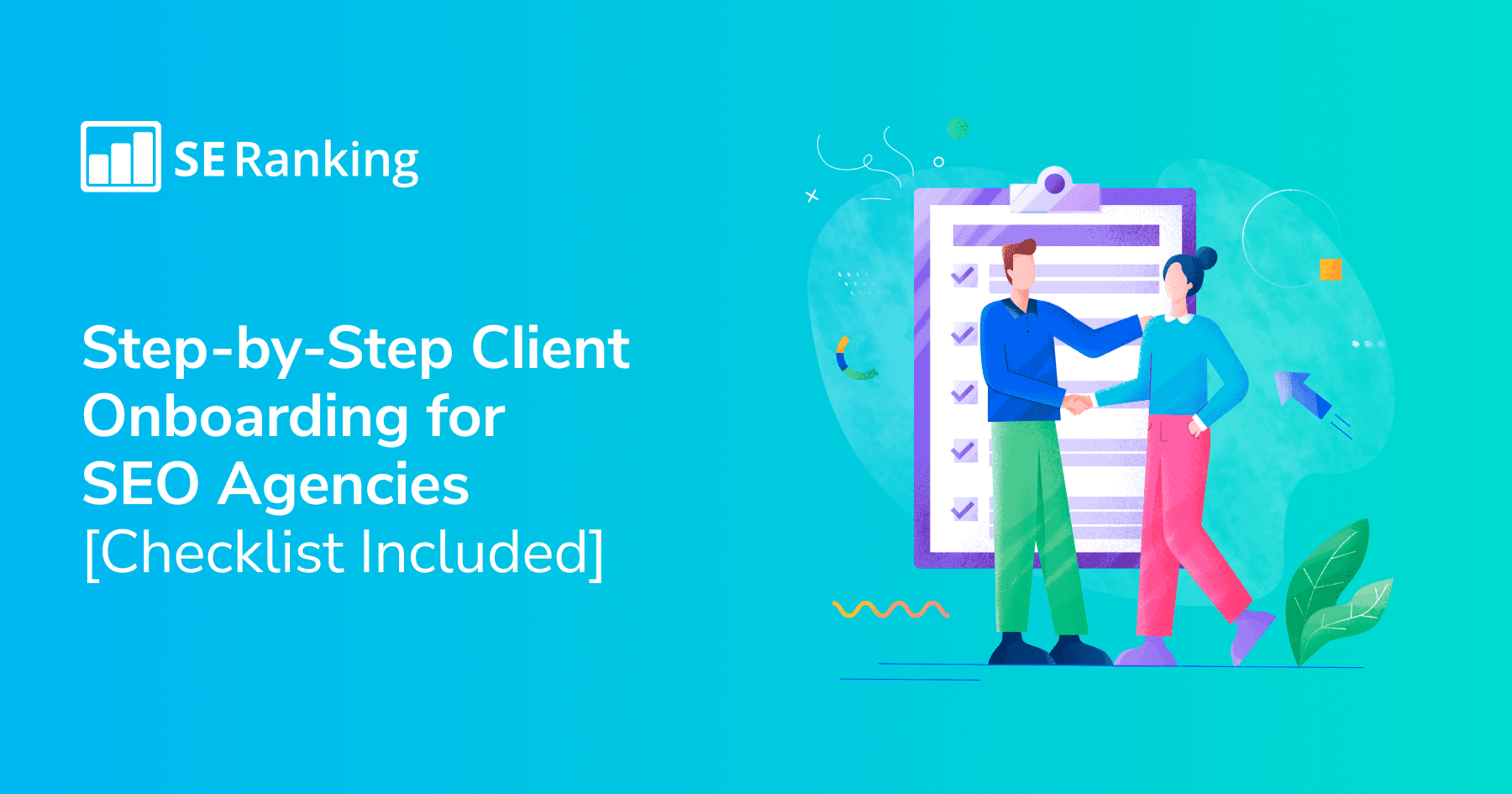
Congratulations on closing that SEO sales deal!
Now it’s time to kick-start your client’s path to success by organizing a top-of-the-line SEO client onboarding process. This will set the tone for future collaboration!
As the owner of the Loopex Digital SEO agency, I have worked with more than 500 clients and have witnessed the power of an effective onboarding process firsthand. You can take my word for it that it is a powerful way to ensure your project starts off on the right foot.
In this article, I will take you through my personal process of holding an onboarding call. I will discuss the key elements and share a set of helpful questions to ask the client.
I’ll also provide special bonus at the end. It’s a free SEO client questionnaire template to help you streamline your onboarding process!
Now, let’s get this show on the road!
Marketers’ Steps for Success in Onboarding New Clients
These are the exact steps I follow in the onboarding process. I’ll break down each step in detail, just as it occurs in practice.
Keep in mind that some of the steps I’ll be sharing are tailored specifically for SEO projects, which are my focus of expertise.
Feel free to customize each step to suit your project type and needs!
Step 1: Introducing the Team
Goal: Building trust and accountability with the SEO team and the new client
Possible bottlenecks: The client’s past negative past experiences with previous SEO teams
Timeframe: 5-7 minutes
The first step in onboarding new clients is introducing them to the team.
This is a crucial stage because it sets the tone for a strong partnership.
When introducing my team, I don’t just list names and positions.
I go a step further by helping the clients get to know the team members. I highlight their unique skills, expertise, and personalities.
I emphasize my team’s skills and personal qualities, including their:
- SEO expertise and experience
- Knowledge of industry trends
- Technical proficiency level
- Strategic thinking
- Results-oriented mindset
- Transparency in communication
- Adaptability
I like to maintain a warm, upbeat atmosphere during meetings. I also prefer to add my own personal touch.
If the client had a negative experience with their previous SEO team, I make sure to address any concerns they might have about mine.
I do this by sharing my team’s experience and expertise, providing examples of successful projects we have worked on, and by outlining our transparent strategy and practices.
Step 2: Defining Project Scope and Deliverables
Goal: Ensure the client fully understands what to expext from the SEO project.
Possible bottlenecks: Unclear requirements/unrealistic expectations
Timeframe: 20 minutes
Next, my team and I begin discussing the stages the new project will go through. We give the client a detailed breakdown of the exact services they will get.
During this step, we define the scope of work and outline the deliverables.
Of course, the services we offer differ from client to client. So, I make sure we use this time wisely to make sure all parties set clear expectations.
Depending on the client’s business goals and how well the website is performing, I suggest custom on-site SEO and link-building strategies to meet the project’s needs
To put it plainly, I evaluate a project’s needs based on its current performance.
Let’s say a website needs a full Technical SEO Audit. Here’s what I would typically do:
- Explain why a technical audit is crucial for the client’s website.
- Describe the technical aspects the checkup tackles: crawlability and indexability assessment, page speed analysis, backlink analysis, etc.
- Introduce our 50-point Technical SEO checklist, which we use to ensure a comprehensive evaluation.
- Provide the timeline: a full technical audit typically takes two weeks to complete.
- Set up a Zoom meeting to present the audit results.
If the client’s expectations and requirements on deliverables are unclear, I usually seek clarification by asking detailed questions about their desired outcomes.
It’s crucial at this stage to clarify the objectives and discuss every detail to set achievable goals.
Step 3: Securing Permissions and Access to Necessary Tools
Goal: Gain access to the website’s analytical tools
Possible bottlenecks: The client may be reluctant to share tool/website access
Timeframe: 5 minutes
To kick off our SEO strategy development, we typically need access and permission to a number of tools.
In this part of the onboarding process, we work closely with our clients to ensure smooth access to tools like Google Search Console, Google Analytics, Google Business Profile, the client’s CMS, and more. You can find a full list of the tools we request in our free SEO questionnaire for clients. I’ll present this list at the end of this article.
Now my team and I understand that security and confidentiality are of utmost importance, so we assure our clients that we follow strict data privacy protocols. We also only request access and permissions that are necessary for the project.
If the client still hesitates to share access with us, we will encourage them to sign an NDA. This generally gives them peace of mind that their data is secure with us.
After the call, we send the client a follow-up e-mail listing the tools we need permissions for.
This step helps establish a seamless workflow, promotes efficient collaboration, and avoids potential bottlenecks.
Step 4: Evaluating Client-Side In-House Resources
Goal: Check the availability of internal resources from the client that can benefit the SEO project.
Possible bottlenecks: Limited client-side resources
Timeframe: 10 minutes
Now that deliverables are set and access information discussed, it’s time to assess whether the client’s internal resources can support our SEO strategy.
This can include people like writers, developers, and UI/UX designers. We also look into valuable materials like whitepapers and e-books.
My team and I evaluate the client’s team’s skillsets, experience, and the time they have available to contribute to the project.
For example, I may ask the client if their in-house developer can handle speed optimization tasks, template development, design implementation etc., or if additional expertise is needed.
I may check if the company has enough content writers to quickly create content clusters, and if they possess basic SEO knowledge to implement the recommendations we provide in our SEO briefs.
This evaluation helps us leverage existing capabilities and resources from the client’s side. And if some resources fall short, we hire new expertise where its needed.
If the client’s in-house team needs additional support to implement our SEO strategy, I typically advise the client to look for experienced freelancers on Upwork. I may also give recommendations based on my previous partnerships and help them during the interview process.
20+ Questions to Ask Your New Clients During Onboarding
Goal: Get a full understanding of the project
Possible bottlenecks: Incomplete data or details about the project
Timeframe: 25-30 minutes
Finally, we’ve reached the good part!
Let’s dive into our tentative list of SEO questions to ask a client during the onboarding call. I ask these questions to ensure we have all the details needed to craft a successful SEO strategy.
Note that I organized these questions into thematic sections for you.
Business overview
Questions like the ones you’ll see below allow us to understand the business and the products better.
Understanding the motivations and unique aspects of the company will help us craft a tailored strategy.
More specifically, these questions help us understand the business’s background, define competition, gain insights for keyword research, predict trends, and tailor SEO efforts to specific products/services.
- What factors influenced your decision to start this business? Is there a particular reason or story that led to it?
- How would you describe your business to someone who is unfamiliar with it?
- Could you provide a description of the products or services your business offers?
- What motivated you to focus on your primary product or service? What specific desire or need does it fulfill?
- What sets your service and product apart from alternatives, including the option to not use any similar offering at all?
- What are the common reasons why customers stop using your service?
- Are there any seasonal trends that we should be aware of?
Common customer сoncerns during the sales cycle.
Understanding what l objections our clients’ customers might have is vital when planning the strategy period.
Being aware of potential customer objections helps us craft a comprehensive and effective SEO strategy that directly addresses them.
Some questions we might ask:
- Are there any limitations or disadvantages associated with your service, product, or business model?
- Do you frequently encounter any common concerns or objections from potential customers during the sales process?
- Are there any common misconceptions or misunderstandings that customers often have about your industry or the solutions you provide?
To handle these concerns in our SEO strategy, we create a data-backed, high-quality content strategy.
For example, let’s say a client offers an innovative product, and customers are worried about how well it works compared to more traditional solutions.
What I would do is create data-backed articles that compare the innovative product to traditional ones in the niche.
An in-depth comparative analysis shows why our product is better. It also targets existing competitor keywords, educates the audience, and raises awareness about our product’s effectiveness.
Demographics & psychographics
These questions help us learn more about the client’s customers, like their age, income, and interests. We use this info to create a content strategy that resonates with their interests and needs.
This involves selecting topics their audience cares about, crafting compelling headlines, and matching the content’s tone and style to their preferences.
By conducting keyword research based on the target audience’s demographics and psychographics, we identify relevant search terms that align with their interests and intentions.
Here are some questions we’d ask the client:
- What’s the target demographic for your business?
- What is the age range of your target audience?
- What income level does your target audience typically fall into?
- Does your target audience include a specific gender or is it more diverse?
- What industries or job roles are typically found within your target audience?
- What occupations or industries are commonly represented within your target audience?
Service/product results
This helps in identifying which aspects and pain points to focus on when creating a content strategy and constructing landing pages.
Relevant questions:
- How do your clients benefit from using your service/product?
- What specific advantages or improvements do your clients experience as a result of using your service?
- How does your service address your clients’ pain points or solve their challenges?
Business marketing overview
Questions about business marketing help us make data-driven decisions, use SEO effectively, and avoid wasting time on ineffective strategies.
By understanding the client’s current revenue, profit margin, best-selling products or services, and past marketing hurdles, we can shape our SEO strategy to match their financial objectives and target high-performing areas.
Here are some questions we’d ask the client:
- How much revenue does your business generate annually? What is the percentage of profit you typically earn?
- Could you provide additional details about your most popular products or services?
- Apart from SEO, what other online marketing channels are you currently utilizing?
- What challenges have you encountered in your marketing efforts? Could you share any past strategies that did not work and explain why you believe they were unsuccessful?
- Can you give a list of your biggest competitors?
- What is the conversion rate for organic traffic on your website?
- What is the AOV (Average Order Value) for your sales?
- What is the average Lifetime Value of your customers?
And now for the exciting part!
I’ve made an SEO client questionnaire template for you to use for your onboarding calls. Now you can find all essential questions in one place!
Here is a free copy of the template.
That about sums it up
So in this article, I revealed the exact same onboarding process that I use to start partnerships with my own SEO clients.
The Onboarding Questionnaire I provided is also a helpful tool for SEO professionals and digital marketers for setting up fruitful collaborations with their clients.
As you move forward, be sure to use this free template for all its worth. It can help streamline your onboarding process and ensure a seamless experience for both you and your clients!



